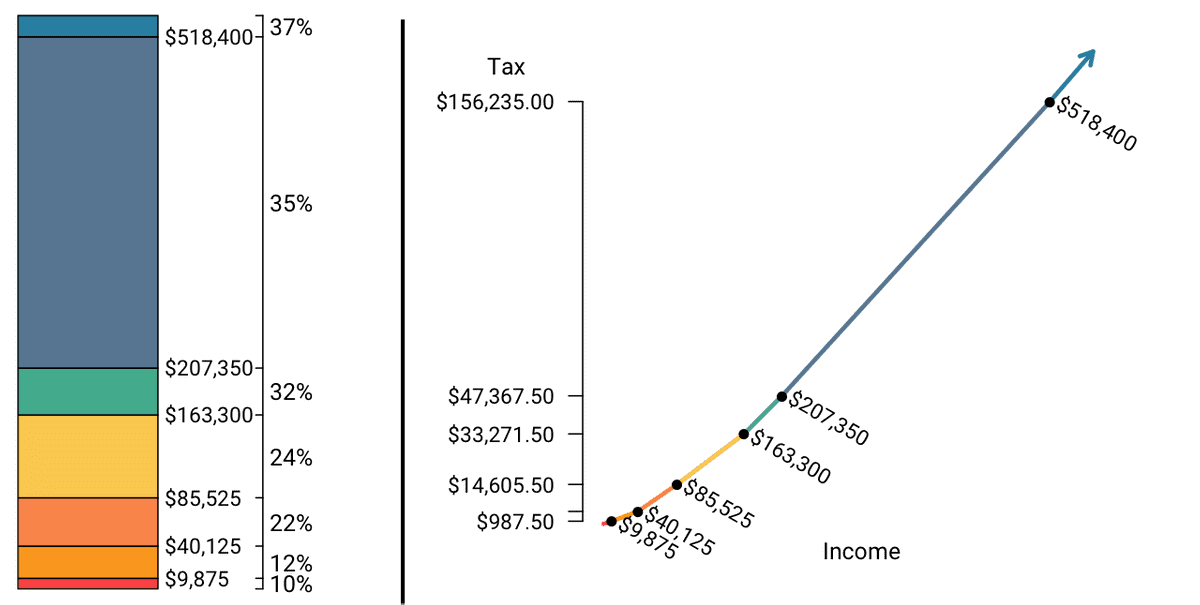Progressive Income Tax
Basics
The United States uses a progressive income tax system. What this practically means is that people with smaller incomes will pay less than those with higher incomes, as a proportion of their income.
Consider a sales tax of 6%, which is a flat rate tax. For a $100 item, everyone has to pay $106, or an additional 6% of the price. If the US income tax was a flat tax, say 20%, then an individual making $30,000 would pay $6,000 (20% of $30,000) and an individual making $300,000 would pay $60,000. Although the higher earner will pay more as a dollar amount, it’s important to consider that many goods and services do NOT scale with income. An individual making $30,000 could have roughly the same grocery bill as the individual earning $300,000. Thus, the lower income earner has a disproportionately higher tax burden. The progressive income tax is an attempt at fixing this problem.
The 2020 US Tax Brackets
For individuals, the following brackets (based on language from the IRS) are used:
| Tax Rate | Cutoff |
|---|---|
| 10% | Incomes of $9,875 or less |
| 12% | Incomes over $9,875 |
| 22% | Incomes over $40,125 |
| 24% | Incomes over $85,525 |
| 32% | Incomes over $163,300 |
| 35% | Incomes over $207,350 |
| 37% | Incomes over $518,400 |
How the US progressive income tax DOES NOT work
A common misconception is that ALL of your money is taxed at a particular rate based on income.
What does NOT happen: the $30,000 income earner is taxed at 12% and pays $3,600 in taxes (12% of $30,000) and the $300,000 earner is taxed at 35% and pays $105,000.
How the US progressive income tax DOES work
Instead, your money is divided into buckets (or brackets) where each subsequent bucket is taxed at an increasing rate. Admittedly, the language surrounding the tax structure is not very clear.
So what actually happens: the $30,000 income earner is taxed at 10% for their first $9,875 and then 12% for their remaining $20,125, thus paying $3,402.50 in taxes ($9,875*0.1 + $20,125*0.12). The $300,000 income earner is taxed at 10% for their first $9,875, 12% for their next $30,250, ..., 35% for their remaining $92,650. They pay $79,795 in taxes ($9,875*0.1 + $30,250*0.12 + $45,400*0.22 + $77,775*0.24 + $44,050*0.32 + $92,650*0.35).
Marginal vs Effective Tax Rate
- Marginal tax rate: the highest tax rate being applied to your income. In the previous examples for the $30,000 earner their marginal tax rate is 12%. For the $300,000 earner their marginal tax rate is 35%. Note that this is only applied to a portion of your income.
- Effective tax rate: the overall tax rate that you pay. In the previous examples for the $30,000 earner has an effective tax rate is 11.3% (3,402.50/30,000). For the $300,000 earner their effective tax rate is 26.6% (79,795/300,000).
Immediate Implications
Should you take that raise?
Suppose you make $40,000 so you’re in the 12% income tax bracket. You’re offered a raise at work that would take your income to $44,000 so now you’re in the 22% income tax bracket. Should you accept this raise even though you’ll be in a higher tax bracket?
YES! Remember that it is only the money that exceeds the previous bracket that is taxed at the higher amount. So it’s only $3,875 that is taxed at 22%, NOT all $44,000. So you will NOT be losing money. Take the raise.
Reducing Taxable Income
Another implication, and one that is evidenced by the previous example, is that if you can reduce your income through, say, tax advantaged accounts or charitable donations, the taxes you are saving come from the highest bracket first and are NOT some average of all the tax brackets before that. Let’s consider the $44,000 earner who decides to save $2,000 in a traditional IRA. This effectively reduces their income to $42,000. The $2,000 they save would have been taxed at 22%.
- © 2020 Explore Personal Finance
- About
- Contact
- Disclaimer
